- EUR/JPY attracts buyers for the third straight day and climbs closer to the weekly top.
- The BoJ uncertainty continues to undermine the JPY and lends support to the cross.
- A neutral technical setup warrants caution for bulls amid the German political crisis.
The EUR/JPY cross builds on the overnight bounce from the vicinity of the 163.25-163.20 horizontal support, or the weekly low and gains some follow-through traction on Wednesday. This marks the third day of a positive move and lifts spot prices to the top end of the weekly range, around the 164.60-164.65 region during the first half of the European session.
The uncertainty over the Bank of Japan's (BoJ) rate-hike plans is seen undermining the Japanese Yen (JPY) and turning out to be a key factor acting as a tailwind for the EUR/JPY cross. That said, speculations that Japanese authorities will intervene in the FX market to prop up the domestic currency, along with a weaker risk tone, should limit losses for the safe-haven JPY. Furthermore, a political crisis in Germany – the Eurozone's largest economy – continues to weigh on the shared currency and should cap gains for the currency pair.
Moreover, neutral oscillators on the daily chart warrant some caution for bulls and suggest that any subsequent move up is more likely to face stiff resistance near the 165.00 psychological mark, or the 200-day Simple Moving Average (SMA). A sustained move beyond should lift the EUR/JPY cross towards the 165.45 hurdle en route to the 165.90-166.00 supply zone. This is followed by a multi-year peak, around the 166.65-166.70 area touched in October, which if cleared should pave the way for the resumption of a two-month-old uptrend.
On the flip side, the 164.00 round figure now seems to protect the immediate downside ahead of the 163.25-163.20 horizontal support. A convincing break below the latter might prompt some technical selling and drag the EUR/JPY cross below the 163.00 mark, towards testing the next relevant support near the 162.50-162.45 region. The corrective decline could extend further towards the 50-day SMA, currently pegged near the 162.00-161.95 zone.
EUR/JPY daily chart
Japanese Yen FAQs
The Japanese Yen (JPY) is one of the world’s most traded currencies. Its value is broadly determined by the performance of the Japanese economy, but more specifically by the Bank of Japan’s policy, the differential between Japanese and US bond yields, or risk sentiment among traders, among other factors.
One of the Bank of Japan’s mandates is currency control, so its moves are key for the Yen. The BoJ has directly intervened in currency markets sometimes, generally to lower the value of the Yen, although it refrains from doing it often due to political concerns of its main trading partners. The BoJ ultra-loose monetary policy between 2013 and 2024 caused the Yen to depreciate against its main currency peers due to an increasing policy divergence between the Bank of Japan and other main central banks. More recently, the gradually unwinding of this ultra-loose policy has given some support to the Yen.
Over the last decade, the BoJ’s stance of sticking to ultra-loose monetary policy has led to a widening policy divergence with other central banks, particularly with the US Federal Reserve. This supported a widening of the differential between the 10-year US and Japanese bonds, which favored the US Dollar against the Japanese Yen. The BoJ decision in 2024 to gradually abandon the ultra-loose policy, coupled with interest-rate cuts in other major central banks, is narrowing this differential.
The Japanese Yen is often seen as a safe-haven investment. This means that in times of market stress, investors are more likely to put their money in the Japanese currency due to its supposed reliability and stability. Turbulent times are likely to strengthen the Yen’s value against other currencies seen as more risky to invest in.
Information on these pages contains forward-looking statements that involve risks and uncertainties. Markets and instruments profiled on this page are for informational purposes only and should not in any way come across as a recommendation to buy or sell in these assets. You should do your own thorough research before making any investment decisions. FXStreet does not in any way guarantee that this information is free from mistakes, errors, or material misstatements. It also does not guarantee that this information is of a timely nature. Investing in Open Markets involves a great deal of risk, including the loss of all or a portion of your investment, as well as emotional distress. All risks, losses and costs associated with investing, including total loss of principal, are your responsibility. The views and opinions expressed in this article are those of the authors and do not necessarily reflect the official policy or position of FXStreet nor its advertisers. The author will not be held responsible for information that is found at the end of links posted on this page.
If not otherwise explicitly mentioned in the body of the article, at the time of writing, the author has no position in any stock mentioned in this article and no business relationship with any company mentioned. The author has not received compensation for writing this article, other than from FXStreet.
FXStreet and the author do not provide personalized recommendations. The author makes no representations as to the accuracy, completeness, or suitability of this information. FXStreet and the author will not be liable for any errors, omissions or any losses, injuries or damages arising from this information and its display or use. Errors and omissions excepted.
The author and FXStreet are not registered investment advisors and nothing in this article is intended to be investment advice.
Recommended content
Editors’ Picks

EUR/USD drops below 1.0800 on Trump's 'Liberation Day'
EUR/USD is back in the red below 1.0800 in the early European morning on Wednesday as investors rush for the safe-haven US Dollar, aniticpating US President Donald Trump’s long-threatened “reciprocal” tariffs package, due to be announced at 20:00 GMT.

GBP/USD trades with caution above 1.2900, awaits Trump’s tariffs reveal
GBP/USD is trading with caution above 1.2900 early Wednesday, struggles to capitalize on the overnight bounce amid resugent haven demand for the US Dollar. Traders remain wary heading into the US 'reciprocal tariffs' announcement on "Liberation Day' at 20:00 GMT.

Gold price remains close to record high amid concerns over Trump’s reciprocal tariffs
Gold price regains positive traction amid concerns about Trump’s aggressive trade policies. Fed rate cut bets keep the USD bulls on the defensive and further benefiting the XAU/USD pair. A broadly stable risk sentiment might cap gains ahead of Trump’s tariffs announcement.

ADP Employment Change projected to show US job growth gaining in March
The US labor market is poised to steal the spotlight this week as concerns over a potential slowdown in economic momentum remain on the rise — an unease fueled by recent signs of slower growth and troubling underlying data, aggravated by the ongoing uncertainty surrounding US tariffs.

Is the US economy headed for a recession?
Leading economists say a recession is more likely than originally expected. With new tariffs set to be launched on April 2, investors and economists are growing more concerned about an economic slowdown or recession.

The Best brokers to trade EUR/USD
SPONSORED Discover the top brokers for trading EUR/USD in 2025. Our list features brokers with competitive spreads, fast execution, and powerful platforms. Whether you're a beginner or an expert, find the right partner to navigate the dynamic Forex market.


